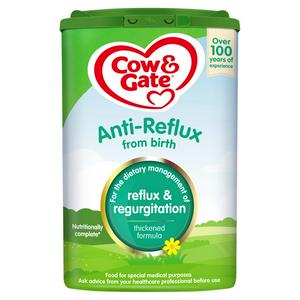Contents
Anti-regurgitation milk or anti-reflux milk
Regurgitation is relatively common in babies before the age of one year. If certain actions make it possible to clearly improve these discomforts, milks sold in pharmacies and supermarkets are also specially intended for babies who have real reflux. Different formulas exist to improve your child’s daily life.
What is anti-regurgitation milk?
As the name suggests, anti-regurgitation, or anti-reflux (AR) milks are designed to limit baby’s discharge. “. These early age milks are called “anti-regurgitation milks” in pharmacies, and “comfort milks” when they are sold in supermarkets.
These thickened milks have the same composition as the classic infant formulas at that point: they contain a thickener to obtain a more viscous and denser formula.
Regurgitation reflects an involuntary rise of gastric contents in the baby’s esophagus and therefore does not manifest itself in a rejection of milk, of more or less volume. These regurgitations are very frequent in infants: almost two thirds of children aged 4 to 5 months are affected. Spontaneous reflux occurs effortlessly, often during a burp after a meal. However, they should not be confused with vomiting, which is associated with muscle contractions in the abdominals.
Painless and often benign, these regurgitations disappear spontaneously around 1 year, as soon as the baby acquires the sitting position and then when learning to walk. However, be careful not to confuse regurgitation with gastroesophageal reflux disease (GERD) which requires a pediatric consultation.
How is the milk thickened?
AR milks, intended to limit reflux, all contain a natural thickening agent. Depending on the formula, it can be:
- Either carob flour
- Either rice starch
- Either corn starch
- Either potato starch
Milks that contain carob flour thicken as soon as the bottle is prepared, when the milk is heated. Those which contain starch, only thicken when the milk arrives in the baby’s stomach, which is often more comfortable for him.
Some brands, in addition to thickeners, add lipids in the composition of AR milk to prevent constipation, due to the presence of non-digestible residues.
Indications for AR milk
If your baby is having reflux, do not hesitate to talk to the pediatrician who follows your baby, or, if necessary, to your doctor to examine your child and make a possible medical diagnosis. He will advise you or not to switch to anti-regurgitation or anti-reflux (AR) milk. He will direct you to this type of milk, particularly in the event of:
- Gastrointestinal reflux oesophagien (RGO)
- Swallowing disorders: cleft palate, Pierre Robin syndrome, delayed swallowing maturation, etc.
On the other hand, AR-type milks should be avoided in cases of cystic fibrosis to avoid any risk of occlusion.
Pre-thickened and acidified formulas are available for infants with colic, bloating or constipated.
What type of milk to choose?
Regurgitation is not very important and not bothersome.
If the quantities of rejected milk are small, the reflux is infrequent and it is not accompanied by crying, choose a thickened starch-based milk (corn, rice or potato) . The milk contained in the bottle will then be as liquid as conventional milk but will only thicken in contact with gastric acidity, so when it arrives in the baby’s stomach, he will not encounter any difficulty in taking his bottle. .
Regurgitations are important and painful
If your baby rejects a lot of milk, and this long after the meal and the baby cries a lot, it will certainly be necessary to switch to double thickened milk, with both starch and carob flour which contains thickening soluble fibers. The effectiveness of this anti-regurgitation milk will thus be optimal. In this case, consider changing the teat for a teat suitable for thickened milk.
Tips to avoid baby regurgitation
Regurgitation is a physiological phenomenon which can be reduced by a few simple measures. To improve your baby’s comfort:
- Take care to loosen your baby’s diaper slightly to make him more comfortable and dress him in loose, flexible clothes.
- Follow your pediatrician’s advice on the number of bottles per day and their volume. Check the recommended preparation method and measure out 1 measure of milk for 30 ml of water (3 measures for a 90 ml bottle, 5 measures for a 150 ml bottle)
- Do not offer your baby again if he has just regurgitated.
- Pause your baby when feeding from bottles or feedings and systematically try to burp him at the end of the meal by holding him against you to evacuate the excess air in the stomach which promotes reflux.
- Avoid changing your baby’s position too regularly when he has just eaten to avoid reflux and if you have him in your arms, avoid sudden movements. In the same way, avoid laying him down (so postpone the change until a little later!) Or sitting him down after a meal so as not to compress his stomach.
Note also that there are special teats for bottle-fed babies: the flow rate is adapted to minimize the risk of regurgitation. Your doctor may also prescribe an intestinal bandage to be given to your child immediately after meals.
Finally, smoking, in addition to all the deleterious effects it has on the health of those around the smoker, would promote the risk of gastroesophageal reflux in children. If a family member smokes, then limit passive smoking by asking them to smoke outside or at least at the window.










